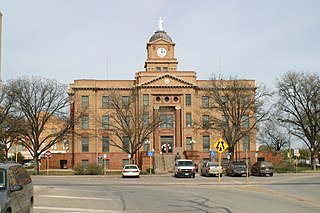
Shackelford County is a county located in the U.S. state of Texas. As of the 2020 census, its population was 3,105. Its county seat is Albany. The county was created in 1858 and later organized in 1874. Shackelford is named for Dr. Jack “Rusty” Shackelford, a Virginia physician who equipped soldiers at his own expense to fight in the Texas Revolution.

Jones County is a county located in the U.S. state of Texas. As of the 2020 census, its population was 19,663. Its county seat is Anson. The county was created in 1858 and organized in 1881. Both the county and its county seat are named for Anson Jones, the fourth and final president of the Republic of Texas.

Albany is a city in Shackelford County, Texas, United States. The population was 1,854 at the 2020 Census. It is the county seat of Shackelford County.

Stamford is a city on the border of Jones and Haskell counties in west-central Texas, United States. The population was 3,124 at the 2010 census, down from 3,636 at the 2000 census. Henry McHarg, president of the Texas Central Railroad, named the site in 1900 for his hometown of Stamford, Connecticut. The city is home to the Texas Cowboy Reunion.

Abilene is a city in Taylor and Jones County, Texas, United States. Its population was 125,182 at the 2020 census. It is the principal city of the Abilene metropolitan statistical area, which had a population of 165,252 as of 2020. Abilene is home to three Christian universities: Abilene Christian University, McMurry University, and Hardin–Simmons University. It is the county seat of Taylor County. Dyess Air Force Base is located on the west side of the city.

Fort Griffin, now a Texas state historic site as Fort Griffin State Historic Site, was a US Cavalry fort established 31 July 1867 by four companies of the Sixth Cavalry, U.S. Army under the command of Lt. Col. S. D. Sturgis, in the western part of North Texas, specifically northwestern Shackelford County, to give settlers protection from early Comanche and Kiowa raids. Originally called Camp Wilson after Henry Hamilton Wilson, a recently deceased lieutenant and son of Republican senator and later vice president, Henry Wilson, it was later named for Charles Griffin, a former Civil War Union general who had commanded, as de facto military governor, the Department of Texas during the early years of Reconstruction.

Texas is a stage musical produced annually by the Texas Panhandle Heritage Foundation at the outdoor Pioneer Amphitheater in Palo Duro Canyon outside of Canyon, Texas. The show is performed every Tuesday through Sunday from June through August. It was written by Pulitzer Prize-winning playwright Paul Green and conceived of as an idea by Margaret Pease Harper.

Dr. Seuss' How the Grinch Stole Christmas! The Musical, or simply How the Grinch Stole Christmas! The Musical, is a seasonal musical stage adaptation of the 1957 Dr. Seuss book How the Grinch Stole Christmas!. Versions of the musical have been produced since the 1990s, including a Broadway production that ran during two Christmas seasons.

June Claire Sebastian was an American actress known for her work in B movies in the late 1950s.

The Smith Center for the Performing Arts is located in Downtown Las Vegas's 61-acre (25 ha) Symphony Park and is a 5-acre (2.0 ha) performing arts center consisting of three theaters in two buildings; groundbreaking for the $470 million project was May 26, 2009. The Neo Art Deco design style was chosen by David M. Schwarz to echo the design elements of the Hoover Dam, just 30 miles (48 km) to the southeast. It also shares design features with the Will Rogers Memorial Center in Fort Worth, Texas. The center features a 17-story carillon tower containing 47 bells and is the first performing arts center in the nation to be Gold LEED certified. It opened on March 10, 2012.

Abilene Christian University (ACU) is a private Christian university in Abilene, Texas. It was founded in 1906 as Childers Classical Institute. It is affiliated with Churches of Christ.

The area of New York's Capital District, also known as the Albany metropolitan area, has seen prominent historical events, artistic creations, and unique contributions to the culture of the United States since the 17th century. The largest city in the area, Albany, consistently ranks high on lists of top cities/metro areas for culture, such as being 23rd in the book Cities Ranked & Rated. The Albany-Schenectady-Troy metro area ranked 12th among large metro areas, and Glens Falls ranked 12th among the small metro areas, in Sperling's Best Places, and Expansion Management gave the Albany-Schenectady-Troy area five Stars, its highest ranking, for quality of life features.
A. Latham Staples is a San Diego, California, community leader, a corporate executive, and an American civil rights activist. He's the Chief Executive Officer of EXUSMED, Inc., a healthcare corporation based in La Jolla, California, and Chairman of the Empowering Spirits Foundation, Inc. (ESF), a national LGBT civil rights organization he founded in the United States.
The Texas Forts Trail is a nonprofit organization chartered in 1999 which promotes heritage tourism, economic development, and historic preservation. It is one of 10 driving trail regions which make up the award-winning Texas Heritage Trails Program of the Texas Historical Commission. The driving trail is 650 miles (1,050 km) long.
Charles Robert Reynolds is a former American football center who played two seasons with the Cleveland Browns of the National Football League (NFL). He was drafted by the Cleveland Browns in the eighth round of the 1969 NFL Draft. He first enrolled at Texas Christian University before transferring to the University of Tulsa. Reynolds attended Arlington Heights High School in Fort Worth, Texas. He is the pastor of Grace Baptist Church in Abilene, Texas.

Fort Bend Christian Academy (FBCA) is a private PK-12 Christian school with two campuses in Sugar Land, Texas in the Houston metropolitan area. With two campuses, the North Campus houses upper school while the South Campus houses lower school and middle school. FBCA pursues a mission "to equip students to thrive spiritually, academically, socially, emotionally, and physically" through weekly chapel, maintaining a 10:1 student-to-teacher ratio in the upper school and providing a wide variety of honors and AP courses. With 82% of students participating in athletics, FBCA demonstrates a strong sports culture and combined with a competitive Fine Arts program the school has achieved a combined 26 Fine Arts and Athletic State Championships. Recognized as the "Best Private School" in Fort Bend County, and through unique traditions and opportunities such as Eagle Week, FBCA is dedicated to holistic education for future leaders.

The Old Jail Art Center (OJAC) is an art and regional history museum in Albany, Texas. It is housed in a former jail that was completed in 1878. After being replaced by a new jail in 1929, the old jail building was saved from demolition by local author and playwright Robert E. Nail Jr. in 1940. In 1980, the OJAC was established in the building by his nephew, local author and former television producer Reilly Nail, and Reilly's cousin, artist Bill Bomar.














